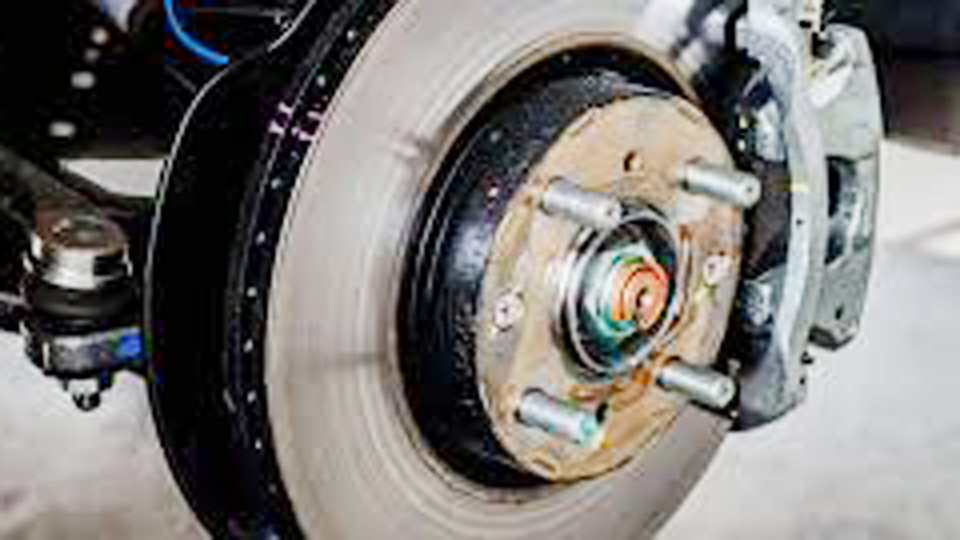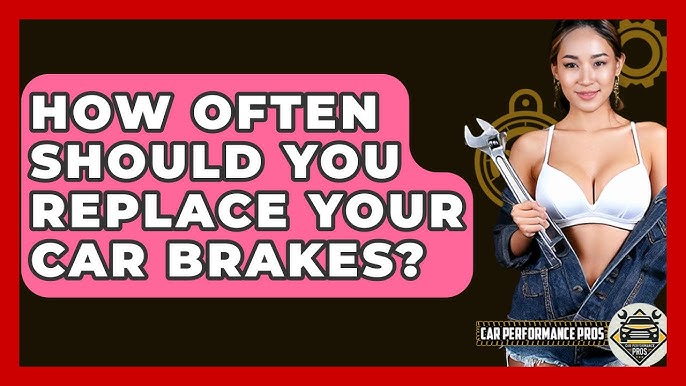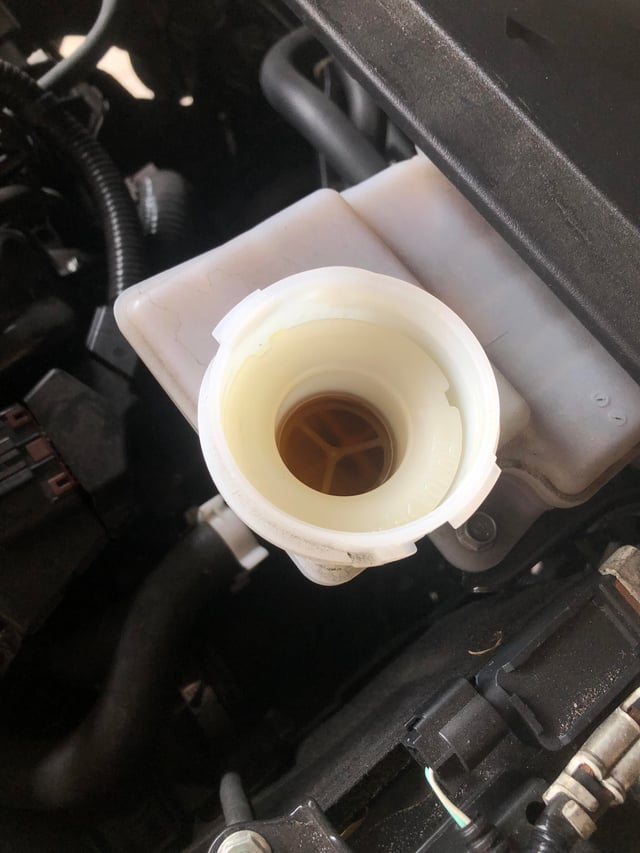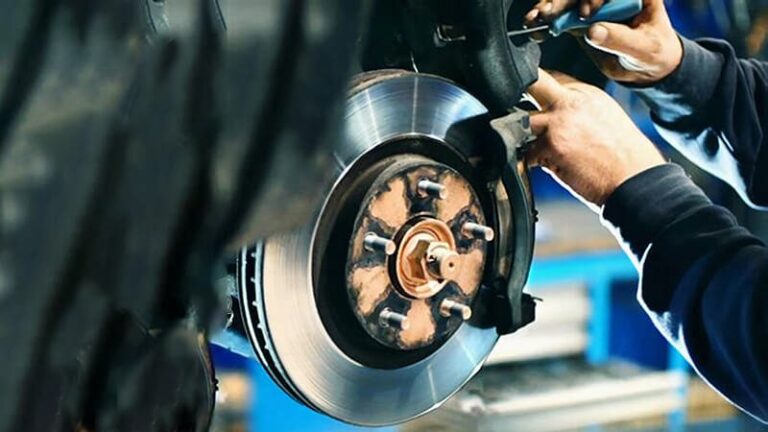When you press the brake pedal and feel the steering wheel shake, it’s natural to wonder, Why does my car vibrate when I press the brakes? I’ve had plenty of cars roll into my garage with that exact complaint, and nine times out of ten, the issue comes down to worn rotors, uneven brake pads, or other parts that need some attention.
The brake system isn’t something you can afford to ignore—it’s directly tied to your safety, the car’s performance, and even your wallet if the problem gets worse. I’ve replaced more rotors and pads than I can count, and one mistake I see drivers make all the time is putting off the repair until it’s too late, turning a simple fix into a costly job.

Photo by capitalgmcbuick
Understanding Your Car’s Brake System
Before diving into the shakes, let’s talk about how your brakes work. Knowing the basics helps you pinpoint why things go wrong, especially if you’re a beginner or just want your car to stop safely.
How Do Car Brakes Work?
When you press the brake pedal, hydraulic fluid pushes the brake pads against a spinning rotor (or disc) in each wheel. This friction slows or stops your car. The rotors are bolted to the wheel hub, and the caliper holds the pads in place. It’s a simple but precise system.
In modern cars, like a Ford F-150 or Toyota Camry, you’ve got disc brakes on at least the front wheels, sometimes all four. Older models or budget cars might have drum brakes in the rear, which use a different setup but can still cause vibrations if faulty.
Why Is a Smooth Brake System Important?
Brakes are your car’s lifeline. Vibrations when braking aren’t just annoying—they can signal issues that reduce stopping power or control. I’ve felt this firsthand on a snowy Michigan road, where a shaky stop nearly sent me sliding. For everyday drivers, this matters for safety in traffic. For enthusiasts, it’s about preserving performance. And for DIYers, catching it early saves money and keeps your ride reliable, whether you’re hauling groceries or towing a trailer.
Common Causes of Brake Vibration
So, why the shakes? Based on my years under the hood and countless brake jobs, here are the usual suspects, tailored to real-world driving conditions across the US.
Warped Brake Rotors
This is the number one culprit. Rotors can warp from overheating, uneven wear, or improper installation. When they’re not perfectly flat, the brake pads grab unevenly, causing a pulsing or vibrating pedal. I’ve seen this a lot in heavy vehicles like SUVs driven hard in stop-and-go city traffic, like in Atlanta or LA.
Worn or Uneven Brake Pads
Brake pads wear down over time, especially if you’re heavy on the brakes in urban areas. If they wear unevenly—say, due to a stuck caliper—you get vibrations. I once fixed a buddy’s Chevy Malibu that shook because one pad was down to metal while the other was fine.
Stuck or Faulty Brake Caliper
The caliper squeezes the pads against the rotor. If it’s sticking (common in salty East Coast winters), it applies uneven pressure, leading to shakes. This can also overheat the rotor, worsening the problem. I’ve freed up calipers on older Jeeps after road salt gummed them up.
Worn Suspension Components
Your brakes don’t work alone. Worn tie rods, ball joints, or control arm bushings can amplify vibrations when braking. This is common in high-mileage trucks driven on rough rural roads, like in Texas or Oklahoma, where potholes take a toll.
Unbalanced or Damaged Wheels
Less common but worth checking—unbalanced tires or bent wheels can mimic brake vibration. If you hit a curb hard in a busy city like New York, it might throw off wheel alignment, causing shakes that feel brake-related.
Here’s a quick table I use to diagnose brake vibrations in my garage:
| Cause | Symptoms | Common in These Conditions |
|---|---|---|
| Warped Rotors | Pulsing pedal, steering shake | Hot climates, heavy braking |
| Worn Brake Pads | Vibration, grinding noise | Urban driving, high mileage |
| Stuck Caliper | Uneven wear, pulling to one side | Salty winters, coastal areas |
| Worn Suspension | Shakes worsen at higher speeds | Rough roads, older vehicles |
| Unbalanced Wheels | Vibration at specific speeds | After hitting potholes or curbs |
Why Brake Vibration Matters
Vibrations aren’t just uncomfortable—they’re a warning. Ignoring them can lead to reduced braking efficiency, longer stopping distances, or even brake failure in extreme cases. On wet or icy roads, like in the Pacific Northwest or New England, that’s a safety hazard. For enthusiasts, it ruins the driving experience. And for DIYers, it’s a chance to save cash by fixing it early before small issues, like uneven pads, wreck your rotors.
How to Diagnose Brake Vibration
You don’t need a mechanic’s degree to figure this out. I’ve diagnosed shaky brakes in my driveway with basic tools. Here’s how you can, too, whether you’re a beginner or a seasoned gearhead.
Step-by-Step Guide to Diagnosing Brake Vibration
Test Drive Safely: Find a quiet road—empty parking lots work great. Brake gently at low speeds (20-30 mph). Note if the vibration is in the pedal, steering wheel, or whole car. Highway speeds (50-60 mph) can amplify suspension-related shakes.
Visual Inspection: Park safely, let the brakes cool, and jack up the car (use jack stands—never trust just a jack). Check rotors for grooves, discoloration, or warping. Look at pads for uneven wear. I’ve spotted warped rotors on my old Honda just by running a finger across the surface.
Check Calipers: Look for rust or leaks around the caliper. Try wiggling it—if it’s stuck, it won’t move freely. Coastal drivers, watch for salt buildup.
Inspect Suspension: Grab the tire and shake it side-to-side and up-down. Play means worn bushings or tie rods. I caught this on a friend’s F-150 after he complained of shakes on dirt roads.
Wheel Check: Spin the wheel to feel for wobbles. Check tire tread for uneven wear, common after hitting potholes in urban areas.
Warning: If you hear grinding or smell burning, stop driving and inspect immediately. Metal-on-metal contact can destroy rotors fast.
Fixing Brake Vibration: DIY or Pro?
Once you know the cause, decide if it’s a DIY job or time to call a shop. I’ve done plenty of brake work myself, but some fixes need pro tools or expertise, especially on newer cars with complex systems.
When to DIY vs Call a Professional
DIY: Good for replacing pads, rotors, or cleaning calipers if you’ve got tools and time. Pros: Saves $200-500. Cons: Time-consuming, and mistakes can damage parts.
Professional: Best for stuck calipers, suspension work, or if you’re not confident. Shops charge $300-1,200 depending on the fix—worth it for safety on daily drivers or high-end cars like BMWs.
Step-by-Step Guide to Replacing Brake Rotors and Pads
This is for disc brakes on common US models like a Chevy Silverado or Honda Accord. Always check your car’s manual for specifics.
Gather Tools and Parts: You’ll need a jack, jack stands, lug wrench, socket set, C-clamp, new rotors (OEM or brands like Brembo), new pads (ceramic for less dust), brake cleaner, and brake fluid.
Prep the Car: Park on a flat surface, loosen lug nuts, jack up the wheel, and secure with stands. Remove the wheel.
Remove Caliper: Unbolt the caliper (usually two bolts). Hang it with a wire—don’t let it dangle. Slide out old pads.
Replace Rotor: Unbolt the rotor (may need a screw or clip). Clean the hub, install the new rotor, and secure it.
Install New Pads: Compress the caliper piston with a C-clamp. Insert new pads, reattach caliper, and torque bolts (check manual, usually 20-30 ft-lbs).
Reassemble and Test: Put the wheel back, lower the car, and torque lug nuts (80-100 ft-lbs typically). Pump the brake pedal to seat pads. Test drive at low speeds.
Warning: Bleed brakes if you open the hydraulic system—air bubbles reduce braking power. In humid areas like Florida, use anti-seize on bolts to prevent rust.
Fixing a Stuck Caliper
If the caliper’s the issue, try cleaning first. Remove it, clean with brake cleaner, and lubricate pins with high-temp grease. If it’s seized, replace it ($50-150 per caliper). I’ve saved calipers on older Dodges this way, but new ones were needed after harsh Ohio winters.
Preventing Brake Vibration
An ounce of prevention beats a pound of repair. Here’s how I keep brakes smooth, learned from years of trial and error.
Maintenance Tips for Healthy Brakes
- Check Pads Regularly: Every oil change (5,000-7,000 miles), inspect pad thickness. Replace if under ¼ inch.
- Resurface or Replace Rotors Early: Don’t wait for deep grooves. Resurfacing ($20-50 per rotor) can work if not too thin.
- Clean Calipers Annually: Especially in salty states like New York or Massachusetts. Use brake cleaner and lube pins.
- Drive Smart: Avoid hard braking in hot weather or heavy traffic—it overheats rotors. Coasting into stops saves wear.
- Rotate Tires: Keeps wheel balance even, reducing strain on brakes. I do this every 6,000 miles on my SUV.
In dusty areas like Arizona, rinse brakes after off-road trips to clear debris. For high-performance cars, upgrade to slotted rotors for better heat dissipation.
Costs of Fixing Brake Vibration
Costs vary by car and region. Here’s a breakdown based on my experience and typical US shop rates:
- Brake Pads: $50-150 per axle (ceramic pricier but cleaner).
- Rotors: $50-200 each (OEM or aftermarket like Raybestos).
- Caliper: $50-150 each, plus $100-200 labor if pro-installed.
- Suspension Parts: $100-500 for tie rods or bushings, plus $200-400 labor.
- Total: $200-1,200 for most fixes, higher for luxury or heavy-duty vehicles.
Pro Tip: Shop independents in smaller towns for lower labor rates than big-city dealers.
Brake Vibration in Different US Driving Conditions
- Urban Areas: Stop-and-go traffic (think LA or Chicago) wears pads fast and overheats rotors. Check pads every 4-6 months.
- Rural Roads: Potholes in places like Kansas or Montana stress suspension, amplifying vibrations. Inspect bushings regularly.
- Hot Climates: Arizona or Texas heat warps rotors quicker. Use high-quality rotors and avoid aggressive braking.
- Cold and Salty Regions: Northeast winters corrode calipers. Rinse undercarriage after snowstorms.
- Mountainous Areas: Steep descents in Colorado or Utah overheat brakes. Downshift to reduce brake strain.
Common Brake Vibration Myths
- Myth: Vibration always means warped rotors. Truth: Pads, calipers, or suspension can also cause it.
- Myth: You can ignore it if stopping is fine. Truth: It worsens over time, hiking repair costs.
- Myth: Only old cars have brake issues. Truth: New cars can shake from cheap parts or hard driving.
Wrapping It Up
Feeling your car vibrate when you press the brakes is a wake-up call, but it’s not a death sentence for your ride. From warped rotors to sticky calipers, the causes are fixable with the right approach, whether you’re turning wrenches in your garage or trusting a mechanic. I’ve been through enough brake jobs to know catching it early saves time, money, and stress—especially on busy US roads or in harsh weather.
Use the steps I shared to diagnose and fix it, and don’t skip regular checks to keep your brakes smooth. Next time you’re under the hood, give those rotors a glance—it could make your next drive safer and more enjoyable.
Frequently Asked Questions
Is it safe to drive with brake vibration?
It’s risky. Vibrations signal reduced braking efficiency, which can be dangerous in traffic or bad weather. Fix it ASAP to avoid longer stopping distances or accidents.
How long do brake rotors last?
Typically 30,000-70,000 miles, depending on driving habits. City commuters replace sooner; highway drivers last longer. Check thickness every oil change.
Can bad tires cause brake vibration?
Yes, unbalanced or damaged tires can mimic brake shakes, especially at higher speeds. Inspect tires and balance them if needed.
How much does it cost to fix brake vibration?
Expect $200-1,200, depending on parts (pads, rotors, calipers) and labor. DIY saves $100-500 but requires tools and skill.
Can I resurface rotors instead of replacing them?
If rotors aren’t too thin, resurfacing ($20-50 each) works. But if deeply grooved or warped, replacement ($50-200 each) is better for safety.



